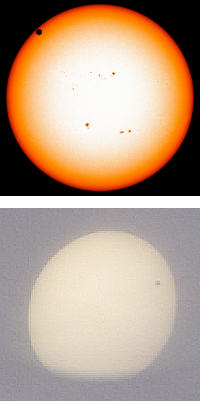
Transit of Venus in 2004
(Bottom: Society Member image)
Both Mercury and Venus are termed inferior planets, as they both orbit around the Sun inside the Earth’s orbit. As inferior planets, on occasion Mercury and Venus can transit across the Sun as seen from the vantage point of Earth. Transits of Venus are extremely rare, occurring in pairs 8 yrs apart separated by intervals of over 100 yrs. A transit of Mercury is less rare, but still only around 13 can occur in any one century. Transits of Mercury can only occur whenever the planet is close to its ascending node or descending node (the points in its orbit where the planet crosses the ecliptic - the apparent path of the Sun against the background stars) heading Northwards or Southwards, respectively. For such an event to take place, the planet must be close to inferior conjunction (i.e. positioned directly between the Earth and the Sun.) and within around 2° of one of these nodes.
At present because of the positioning of the nodes in relation to the Earth's orbit, transits can only occur in the second week of May (descending node) or in the second week of November (ascending node). The ascending and descending nodes of the planets are positioned exactly 180° apart - hence the six-month difference between these two dates. Because the node positions change very slowly over time, dates of Mercury transits drift about 1½ days later per century.
Transits of Mercury at the descending node take place when the Sun and Mercury are positioned in the constellation of Aries, the Ram whilst those at the ascending node take place when the two celestial bodies are positioned in Libra, the scales.
May transits of Mercury repeat at intervals of 13, 33 and 46 years, whilst those in November repeat at intervals of 7, 13 and 46 years. November transits also outnumber May transits in the approximate ratio of 7:3. May transits are slower than November transits because Mercury is then closer to the aphelion point in its orbit (i.e. its furthest point from the Sun) and its orbital speed is therefore slower. November transits are swifter because the planet is then near perihelion (its closest point to the Sun) and so its orbital speed is faster.
The coming transit on May 9th lasts about 2½ hours longer than the previous one in November 2006, with the added bonus for observers that the path of Mercury also passes closer to the Sun's centre and is therefore slightly longer, so that from our location this equates to approximately 7 hours 23 minutes.
- Log in to post comments

